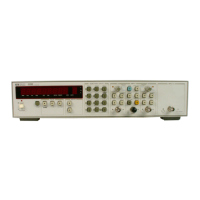8-32. Disassembly and Reassembly Procedures
8-33.
Procedures for removal and installation of the cover and chassis are described in paragraphs
8-280
through
8-286.
Procedures for removal and installation of the Front Panel assembly are described in paragraphs
8-287
through
8-290.
Also, disassembly procedures for troubleshooting the internal components of the Option
010 Oven Oscillator are described in paragraphs
8-397
through
8-399.
For procedures
on
field installations of
Option 010 Oven Oscillator, refer to paragraph
8-475.
8-34. Post-Repair Adjustments
8-35.
Table
5-2
describes the adjustment procedures that are related to repair or replacement of a functional
block of the instrument.
8-36. Post-Service Product Safety Checks
8-37.
Visually inspect interior of instrument for any signs of abnormal internally generated heat, such as dis-
colored printed circuit boards or components, damaged insulation, or evidence of arcing. Determine and remedy
cause of any such condition.
8-38.
Using a suitable ohmmeter, check resistance from instrument enclosure to ground pin on power cable
plug. The reading must be less than one ohm. Flex the power cable while making this measurement to determine
whether intermittent discontinuities exist.
8-39.
Check any indicated front or rear panel ground terminals marked, using the above procedure.
8-40.
Check resistance from instrument enclosure to line and neutral (tied together) with the power switch
ON
and the power source disconnected. The minimum acceptable resistance is two Megohms. Replace any com-
ponent which results in a failure.
8-41. SCHEMATIC DIAGRAM NOTES
8-42.
Figure
8-1
shows the symbols used on the schematic diagrams. This same figure also shows the method of
assigning reference designators, assembly numbers, and subassembly numbers.
8-43. Reference Designations
8-44.
Assemblies such as printed circuit boards are assigned numbers in sequence, Al, A2, etc. Reference
designators for individual components are determined by adding the assembly number as a
prefi for component
number. For example, the complete reference designation for
U1 on assembly A1 is AlU1.
8-45. Identification Marks on Printed Circuit Boards
8-46.
HP
printed circuit boards, as shown in
Figure
&I,
have four identification numbers: an assembly part num-
ber, a series number, a revision letter, and a production code. The assembly part number consists of 10 digits
(such as
05334-60016) and is the primary identification.
All
assemblies with the same part number are interchan-
geable. When a production change is made on an assembly that makes it incompatible with previous assemblies,
a change in part number is required.
HP
5334B
-
Service
Manual
8-4

